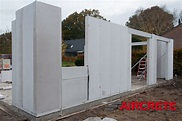Autoclaved Aerated Concrete (AAC): Will Africa Ever Lighten Up In Building?
- Aircrete Africa
- Jan 27, 2018
- 4 min read
Updated: Feb 17, 2018
Lighter, more fire-resistant, and a better insulator, autoclaved aerated concrete caught on in the rest of the world ages ago. It's taking a lot longer in Africa.
The porous AAC structure comes from being "leavened" with aluminum.
To read what manufacturers and distributors say about it, you'd think autoclaved aerated concrete (AAC) was some kind of new, space-age environmental miracle.
Although it certainly has some nifty properties, AAC isn't new and isn't miraculous--but it's certainly popular in Europe, and has been for decades; according to one source, it accounted for 60% of all new construction in Germany in 2006. It has enjoyed pretty flat market share (of near zero) here in the U.S., though, since it was first introduced in the 1990s.
Is there space for AAC in the U.S. market? Should the green building community be working to make space?
How AAC is made
AAC is similar to other concrete types, except that it contains no aggregate; sand or fly ash is included, with aluminum powder added to react with one of these ingredients and "leaven" the concrete, creating tiny bubbles just like baking soda does when it reacts with the buttermilk in your muffin batter. (Your muffins are full of carbon dioxide bubbles, but AAC is full of hydrogen bubbles.)
[Note: Robert Riversong points out in comments that sand is aggregate, which I also thought when I started researching it, but after some more digging, my understanding is that the sand is used as a reactant and is therefore not considered aggregate in AAC.
The concrete is poured into molds, left to rise, and then "baked" in an autoclave, which uses steam and pressure to complete the chemical reactions and speed up the curing process significantly--completing in hours rather than weeks. The resulting blocks are so full of bubbles that a block of the same size has about one-fifth the material required by regular concrete.
Like conventional concrete masonry units, AAC is sold in a variety of block shapes and sizes, but unlike conventional units, most don't have cores. They are porous and light, like muffins, but not hollow.

Benefits of AAC
The main advantage of AAC when it was first developed in Sweden in the early 20th century was simple: it wasn't wood. It's still not wood, but in North America (unlike in Sweden at the time and in most of Europe now), wood is still plentiful and cheap.
Compared with conventional concrete, AAC still has advantages, though:
It uses less material--important for concrete, since in Africa cement is one of the most energy- and carbon-intensive building materials.
Despite the energy-intensive autoclaving process, manufacturers say it takes about 50% less energy to make, because of the lower cement content by volume (we're haven't found anyone to challenge those claims, but are still looking for data).
It's lighter, which cuts down on transportation costs and fuel use.
It's a better insulator, with a steady-state R-value just a hair above R-1 as opposed to something more like R-0.2 (neither of these factors in thermal mass, which we'll get to later).
Air leakage is minimal.
AAC also has excellent soundproofing properties.
It can also be used as a firebreak.
Drawbacks of AAC
In a report written for UC–Davis (PDF), Stefan Schnitzler finds few disadvantages to AAC. Here are the two demerits on his list:
There are few manufacturers in Africa. (that was in 2006, and now there are almost none, since Xella has moved its Hebel operation to Mexico); this means higher costs, which is a huge barrier for adoption.
AAC requires a learning curve for builders, because the mortar application is more precise.
We would like to add a few drawbacks that we've found:
The barriers for builders don't stop with the mortar. According to Derek Taylor, owner of AAC distributor SafeCrete, the only manufacturer in North America right now is a German company whose block dimensions don't work for U.S. builders. These often need to be sawed, adding labor and fuss to a building system that's supposed to be simple. (Taylor's looking forward to two new plants coming online in the States in the next couple years.)
Since right now your AAC is most likely coming from Mexico, the advantages offered by lighter weight will diminish significantly as the mileage increases.
Thermal properties are better than those of conventional concrete, but they aren't good enough to make AAC a viable wall material (relative to BuildingGreen-recommended R-values) in most U.S. and Canadian climates without additional insulation. (The European climate, where AAC is popular, is milder.)
Unless rebar is added--which adds to the weight and amount of material in the blocks--AAC can only be used for low- and mid-rise construction. But it seems to be popular for single-family homes as well as schools.
Unlike conventional concrete, AAC can't be used as a finish; it is more porous and needs cladding or stucco on the outside so it won't absorb moisture.
AAC is popular for residential construction but not suitable for high-rise buildings without structural reinforcement.
Would you use AAC?
That said, AAC does appear to have significant advantages for applications where conventional concrete would normally be the best material--like in the American Southwest and in other climates where thermal mass can increase the "effective" or "mass-enhanced" R-value of the wall. Even then, its performance may still be outmatched by that of insulated concrete forms, depending on the needs of the client.
Unfortunately, much of the information we have on AAC performance in the U.S. comes from manufacturers. We'd like to hear some empirical evidence from the field.
Are you using AAC on any of your projects?
If you've used it, how did it perform? If not, what would it take for you to try it out?




Comments